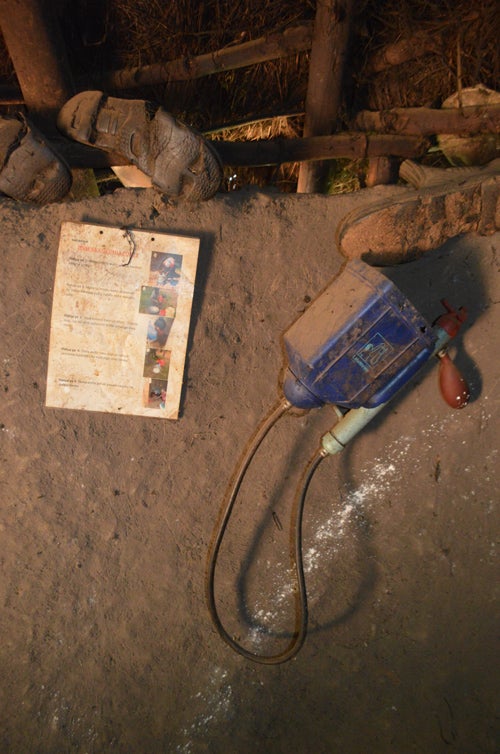A mechanism used as part of international efforts to reduce emissions has a potentially fatal flaw, according to a new study. A recent review of the way carbon offset credits have been used internationally to reduce carbon emissions suggests that the program needs independent monitoring. The issue is particularly timely given that the Paris Agreement, a historic international climate change pact that includes provisions relating to carbon markets, goes into effect Nov. 4.

A LifeStraw filtering device in a rural Kenyan home. These devices were distributed to earn carbon offset credits for averting the use of fuel to boil water. (Image credit: Amy Pickering)
The research, led by Amy Pickering, an engineering research associate at the Stanford Woods Institute for the Environment’s Program on Water, Health and Development, examined a carbon offset program involving distribution of water filters in Kenya and found inaccuracies in self-reported data. Pickering and her colleagues recommend third-party monitoring to ensure the effectiveness of such schemes, in which governments, industry and individuals offset their emissions by purchasing credits representing carbon dioxide removed or reduced from the atmosphere.
“Our message to recommend independent monitoring of greenhouse gas emission projects is especially timely considering global ratification of the Paris Agreement has reached the threshold needed for the agreement to go into force,” said Pickering.
As agreed to by delegates at international climate talks, implementers of carbon offset programs are allowed to collect their own monitoring data to be used by certification organizations to determine how many carbon credits they should be awarded. They can then sell their credits and profit from the programs.
Carbon offset estimates
Curious whether organizations are estimating their offsets accurately, Pickering and her colleagues analyzed one such carbon offset effort in Kenya’s Western Province. In it, the Vestergaard Frandsen company distributed for free more than 800,000 carbon-based drinking water filters to rural households.
The idea behind the program, LifeStraw Carbon Credits, is that water filters help households avoid the need to burn fuel to boil and purify water, earning carbon offset credits for Vestergaard. Under the rules of the voluntary carbon trading market, the company could use its own data to quantify the amount of carbon its program offset and, therefore, the number of credits it had earned. In generating baseline data, Vestergaard calculated the amount of emissions theoretically released from households that would ordinarily boil drinking water if they had access to sufficient fuel and resources.
The program earned Vestergaard nearly 4.5 million credits during a 32-month period ending in January 2014, which the company could sell in the market or on its website for $12.95 each. Due to fluctuations in the price of carbon credits and unreleased implementation costs, Vestergaard’s profits and losses from the program are not publicly known.
Actual usage
Pickering’s team found that only 19 percent of households reported continued use of the free filters 2 to 3 years after receiving them – four times fewer households than reported by Vestergaard’s internal monitoring.
Of the households Pickering and her colleagues surveyed, half reported their filters were not working after 24 to 36 months. When asked about issues preventing use of LifeStraw, 35 percent of households that received a filter said it was too slow or took too much time, 17 percent said it was blocked or not working, 8 percent said it had a bad smell or taste and 7 percent thought the filter was bad for their health.
Other groups have raised questions about Vestergaard’s approach. Gold Standard, a standard and certification organization that assesses carbon offset projects based on submitted monitoring data, states on its website that it “responded to all concerns raised” about the project and will review it again “at the next verification, which has not yet been scheduled.”
Pickering, who is a fellow at the Center for Innovation in Global Health, and her co-authors conclude that carbon financing could be a financially sustainable tool for scaling up water treatment and improving health in low-income settings. However, no one can know for sure without third-party monitoring.
Carbon offset programs are still relatively new, and many need to be adjusted over time in order to ensure they are effective, according to climate scientist Katharine Mach, a senior research scientist at Stanford’s School of Earth, Energy & Environmental Sciences. Mach co-directed the scientific activities of a U.N. Intergovernmental Panel on Climate Change working group, which created reports used to inform the Paris Agreement. “As we experiment with new approaches to climate responses, learning will be an essential part of the picture.”
Coauthors of “Climate and Health Co-Benefits in Low-Income Countries: A Case Study of Carbon Financed Water Filters in Kenya and a Call for Independent Monitoring” include Benjamin Arnold and John Colford Jr. of the University of California, Berkeley; Holly Dentz of the University of California, Davis, and Innovations for Poverty Action, Kenya; and Clair Null of Innovations for Poverty Action and Mathematica Policy Research.
The work was funded by the Bill and Melinda Gates Foundation.
Media Contacts
Rob Jordan, Stanford Woods Institute for the Environment: (650) 721-1881, rjordan@stanford.edu
Amy Pickering, Program on Water, Health and Development: (510) 410-2666, amyjanel@stanford.edu